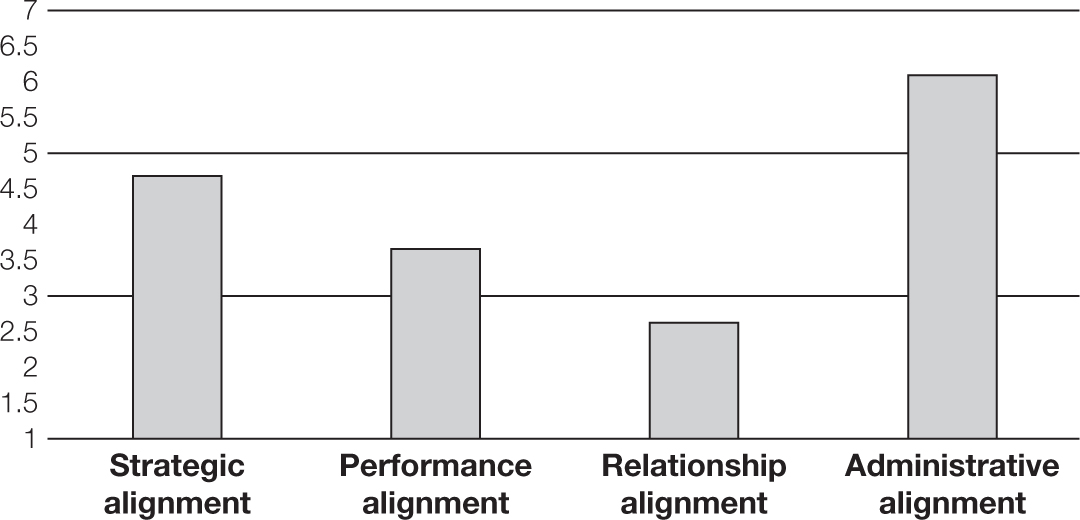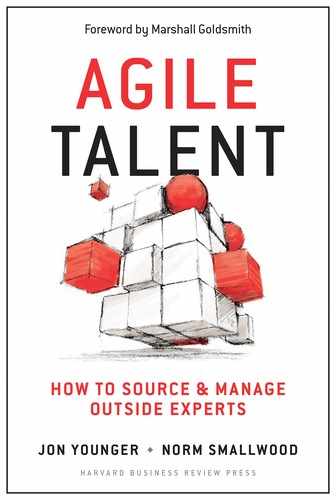Appendix
Your Company’s Agile Talent Effectiveness Quotient (EQ)
The response to the concept of agile talent has been exciting and gratifying. We’ve made dozens of presentations and led many workshops with executive teams as we’ve developed and tested the concepts and tools. The response has been both encouraging and very helpful in building a shared methodology and framework for improvement. As one thoughtful executive put it, “None of these ideas are revolutionary, and yet, in totality, it is a revolutionary approach. I can’t think of an organization I know that has put these ideas to work in managing external talent. Thank you for considerably increasing my toolkit in an area of real and increasing importance to us.”
Agile Talent isn’t the first book to identify the profound workforce shift that we call cloud resourcing. Whatever terms are used—the gig economy, the sharing revolution, or the freelancer movement—numerous pundits have pointed to the shift. But describing the shift is the easy part. The ability to take fuller advantage of the shift to improve organizational performance is the missing link thus far.
Our work closes the gap. It’s not enough to admire the shift. Our focus is what to do about it to create opportunity and value. What specifically can organizations and their leaders do to take practical advantage of their investment in external talent? In other words, how can organizations attract the right external talent, give these individuals the right work, engage them, establish a collaborative environment, and manage and organize the work in the most productive and effective way?
A key tool to get started is what we call the agile-talent effectiveness quotient (EQ). This appendix introduces the EQ survey we’ve developed, with a taster presented here. The full version of the EQ survey is available online at our website, agiletalentcollaborative.com.
We have also taken the suggestion of HR and line executives to form a collaborative organization we call the Agile Talent Collaborative. The team has created a new venture to focus on the effective management and performance of external talent and is creating the methodology and tool kit to provide the strategic advisory services, the global database, and other tools to implement best practices and put in place the change-management skills and activities to make agile talent a sustainable source of value.
This appendix, along with the resources available on Agile Talent Collaborative (or ATC), shows how using the survey and other tools presented in Agile Talent can significantly increase a leadership team’s understanding of how specific changes can break down the problem, improve performance, plan more effectively for change, and make more specific and targeted improvements.
How to Use the Agile Talent (EQ) Survey
The four dimensions of effective external talent management—alignment along strategic, performance, relationship, and administrative dimensions—described in chapter 1, form the basis of a brief but comprehensive survey of agile talent effectiveness.
The following questions represent a subset of the items in the more comprehensive agile talent EQ survey presented at the website agiletalentcollaborative.com. By answering these questions, you can begin to assess how effective your organization is at attracting and managing agile talent. For each item, rate your organization from 1 to 7, where 1 means “consistently inadequate,” 4 means “mixed,” and 7 means “consistently excellent.”
-
STRATEGIC ALIGNMENT: How well linked is our agile-talent approach to our strategy; clear, achievable goals; the right level of sponsorship; and a realistic budget and schedule?
_____ We use a consistent set of criteria in choosing outside partners. _____ We ensure that the work of external resources is based on realistic goals and time frames. _____ When the scope of work changes, the budget and schedule implications are addressed collaboratively. _____ We make sure our external resources understand the broader context and impact of the work they are doing. - PERFORMANCE ALIGNMENT: How well do we provide clear objectives, timelines, and metrics; disciplined and rigorous assessments; and useful and actionable feedback?
-
RELATIONSHIP ALIGNMENT: How well do we ensure cultural fit with our agile talent, and how good are our onboarding and orientation, engagement and involvement, and problem resolution processes?
_____ We do a good job of onboarding our agile talent to the organization’s culture and way of working. _____ We keep external resources up-to-date on what’s happening in our organization, especially where their work is concerned. _____ We actively seek feedback from our external resources on how we can improve. _____ We consider external resources our partners, so we treat them as partners. -
ADMINISTRATIVE ALIGNMENT: How well do we treat externals and handle nonbureaucratic procedures, prompt payment, and problem resolution?
_____ We ensure that external resources know our expectations, including pertinent rules and procedures before they begin work. _____ We are tough but fair and reasonable in negotiating fees and expenses. _____ We do not burden agile talent with unhelpful bureaucracy or excessive administrative requirements. _____ When hiring agile talent, our decision making is reasonably prompt.
Depending on your scores on the above items, you can make some interesting observations by following these steps:
-
ADD UP YOUR SCORES ON THE SURVEY. The team can quickly see areas of relative strength and concern in the four areas of alignment—strategic focus, performance management, effective internal and external relationships, and administrative ease
Figure A-1 is an example of one individual’s completed survey. The chart offers immediate insight into the areas where she believes the organization is doing an excellent job of working with agile talent or where improvement is desirable or necessary. In this case, strategic alignment and administrative alignment are either mixed or better. However, relationship alignment—engaging external talent and ensuring good ongoing communication, internal staff skills, and the right orientation in working with external colleagues—is a pressure point and should be addressed. And performance alignment is also at the low end and should be examined. Does the organization have an effective, efficient, and ongoing protocol for the performance management and feedback of external talent?
-
COMBINE INDIVIDUAL RATINGS INTO A TEAM PROFILE. In combining ratings, you can see the overall pattern and can compare them with external talent ratings to identify areas of disagreement. As a group, the average of these ratings builds an overall perspective on perceived strengths and weaknesses. It is important to look at both overall and individual or subteam ratings to ensure a complete and accurate picture of where strengths lie and where improvement is needed. For example, working recently with an executive team, the head of the business initially described a rosy view of the composite agile talent EQ. However, when all members of the leadership team had weighed in, it was clear that the organization had work to do.
FIGURE A-1
Example of agile talent effectiveness quotient (EQ) results

In this example, an executive used the EQ survey to rate her organization’s effectiveness in managing agile talent. There were eight items per category, with a numerical rating scale of 1 to 7, where 1 = consistently inadequate, 4 = mixed, and 7 = consistently excellent. To use the same approach for a team, a manager could either add up individual ratings or average the ratings of team members.
- ASK KNOWLEDGEABLE AND VALUED EXTERNAL TALENT TO COMPLETE THE SURVEY. In so doing, ask them to describe their experience of working with your organization. Now compare their perspective with that of the internal team. Then, compare these external ratings with the ratings of the leadership team. Use this point of comparison to identify missed areas of strength and need for improvement.
- IDENTIFY TWO OR THREE AREAS WHERE CHANGE IS NEEDED AND WHERE THE COST OR TIME INVOLVED IN MAKING CHANGE IS MANAGEABLE. Using the team ratings, or combination of internal and external ratings, identify two or three areas where change would be beneficial. There is no right or wrong in identifying needs for improvement, but we suggest that the approach focus on two dimensions: what areas will provide the best return on improvement, and where is the cost or difficulty required to change manageable. Processes like “work out” are helpful means of determining the change plan and getting key people on board for the change (see chapter 9).
- ESTABLISH RESPONSIBILITIES FOR MAKING THE CHANGES, DEVELOP A TIMELINE, AND PROVIDE RESOURCES IF NEEDED. For example, can the changes be made within thirty to sixty days? Again, processes like “work out” are helpful in this step,
- FOLLOW UP, APPROVE THE CHANGES, AND IDENTIFY ADDITIONAL NEEDS FOR IMPROVEMENT. Finally, ensure a rigorous approach to follow-up and approval. By setting clear and rigorous (but achievable) deadlines and utilizing a formal process of review, you are likely to achieve greater practical benefit.
For More Diagnostics and Tools
At the Agile Talent Collaborative website, you will find a large and quickly growing global database on agile talent EQ. The site also shows more generally how top companies work with external agile talent to build competitive capability and advantage. The ATC database provides leadership teams with immediate insight on the specific areas where change will lead to more effective use of agile talent. We encourage you to complete the full online survey at agiletalentcollaborative.com. Upon completion, you will receive a comparison of your scores with global trends and will readily see where your scores are higher than the norm and potentially represent best practices, but also where your scores are well below average. Comparing the ratings of your organization’s agile talent EQ with those of the hundreds of organizations in the ATC database will provide useful guidance on where change is needed in your organization.
